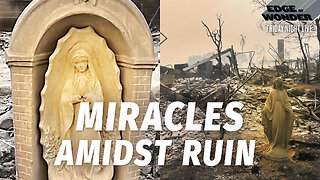Premium Only Content

At the Rooftop of Faith: Exploring Yulla Kanda, the World’s Highest Krishna Temple, Himachal Pradesh
Yulla Kanda: The World’s Highest Lord Krishna Temple in Himachal Pradesh
Nestled high in the majestic Himalayas of Himachal Pradesh, Yulla Kanda is home to a remarkable temple dedicated to Lord Krishna, renowned as the world’s highest temple for this beloved deity. Situated at an astonishing altitude of approximately 14,000 feet (about 4,267 meters) above sea level, this temple not only offers breathtaking panoramic views of the surrounding mountains but also serves as a spiritual haven for devotees and travelers alike.
The Significance of Lord Krishna
Lord Krishna is one of the most revered deities in Hinduism, celebrated for his playful personality, divine love, and wisdom. He is often depicted as a protector and guide, and many believe that worshiping him at a high-altitude temple like Yulla Kanda provides a unique spiritual experience. The temple's elevation is symbolic, representing a higher state of consciousness sought by devotees. Many believe that here, amidst the serenity of the mountains, the heart can more easily connect with divine energies.
The Trek to Yulla Kanda
The trek to Yulla Kanda is an adventure that combines natural beauty with spiritual exploration. Here’s an overview of the trek, including important details and tips for travelers:
Starting Point
The journey usually begins in a nearby village, often Jibhi or Banjar, both of which are accessible from larger towns like Aut or Manali. These villages serve as base camps for those embarking on the trek.
Trek Route
Initial Ascent: The trek typically begins with a moderate ascent through lush pine forests, offering scenic views of the valley below. The initial part of the trek allows trekkers to acclimatize to the altitude while enjoying the diverse flora and fauna.
Rugged Terrain: As trekkers move higher, the path becomes more rugged and challenging, requiring careful navigation over rocky outcrops and occasional stream crossings. Travelers may encounter local wildlife and beautiful wildflowers, especially in the summer months.
Stunning Views: The trail features breathtaking views of the surrounding Himalayan peaks, with several vantage points ideal for photography and rest. The solitude of the environment enhances the spiritual ambiance as trekkers immerse themselves in nature.
Higher Altitude: Gaining elevation requires physical endurance, as the air thins and temperatures drop. Trekkers should be mindful of their health, taking regular breaks, staying hydrated, and watching for signs of altitude sickness.
Final Stretch: The final approach to Yulla Kanda is usually the most challenging but rewards trekkers with majestic views of the temple perched against a backdrop of sprawling mountains. Here, the sense of accomplishment is palpable as pilgrims and travelers alike approach the temple grounds.
Duration and Difficulty
The entire trek can take anywhere from three to five days depending on the chosen route, pace, and the weather conditions. It’s considered moderately difficult, making it suitable for the average trekker with some training or experience. Those with fitness and hiking experience will find the challenges manageable, while beginners should prepare thoroughly and consider hiring local guides for assistance.
Preparation Tips
Physical Fitness: Prior physical conditioning is essential to tackle the rigors of high-altitude trekking. Cardio exercises, strength training, and practice hikes can all be beneficial.
Acclimatization: Spend some time at lower altitudes before the trek to acclimatize to the elevation.
Gear: Essential gear includes sturdy trekking boots, layered clothing, a good-quality sleeping bag, trekking poles, and a backpack with water purification methods and lightweight camping gear.
Supplies: Carry sufficient food, water, and first-aid supplies. It's advisable to pack high-energy snacks like nuts, dried fruits, and protein bars.
Local Guides: Hiring a local guide can greatly enhance the experience, providing insight into the history, culture, and terrain, as well as ensuring safety on the trek.
Conclusion
The trek to Yulla Kanda is more than just a physical journey; it is a pilgrimage that leads one through stunning landscapes toward a spiritual sanctuary. With its rich history, breathtaking views, and the deep devotion associated with Lord Krishna, Yulla Kanda offers a unique experience for those seeking both adventure and a connection with the divine. Travelers leave with not just memories of the stunning vistas but also with a renewed sense of peace and spirituality that accompanies their time in this sacred space.
-
 51:58
51:58
PMG
9 hours ago $2.41 earned"Can the Government Learn from Elon Musk’s 70% Labor Cut? A Deep Dive into Inefficient Agencies"
38.1K -
 6:39:15
6:39:15
Amish Zaku
8 hours agoRumble Spartans #10 - New Year New Maps
33.6K2 -
 1:04:58
1:04:58
In The Litter Box w/ Jewels & Catturd
1 day agoNo Tax On Tips! | In the Litter Box w/ Jewels & Catturd – Ep. 722 – 1/17/2025
152K32 -
 5:35:39
5:35:39
Dr Disrespect
15 hours ago🔴LIVE - DR DISRESPECT - WARZONE - CRAZY CHALLENGES
173K33 -
 1:16:30
1:16:30
Edge of Wonder
11 hours agoLA Fire Updates: Miracles Amidst the Devastation
46.8K14 -
 54:54
54:54
LFA TV
15 hours agoBanning Mystery of the Ages | TRUMPET DAILY 1.17.25 7pm
39.9K8 -
 1:47:13
1:47:13
2 MIKES LIVE
8 hours ago2 MIKES LIVE #168 Open Mike Friday!
34.1K3 -
 1:05:11
1:05:11
Sarah Westall
9 hours agoMysterious Fog and California Wildfires Both Contain Dangerous Elements w/ Dr Robert Young & Hazen
54K7 -
 1:40:48
1:40:48
Mally_Mouse
8 hours agoLet's Play!! -- Stardew Valley pt. 23!
29.1K -
 16:21
16:21
China Uncensored
11 hours agoCan Anything Stop the Tiktok Ban?
39.6K13